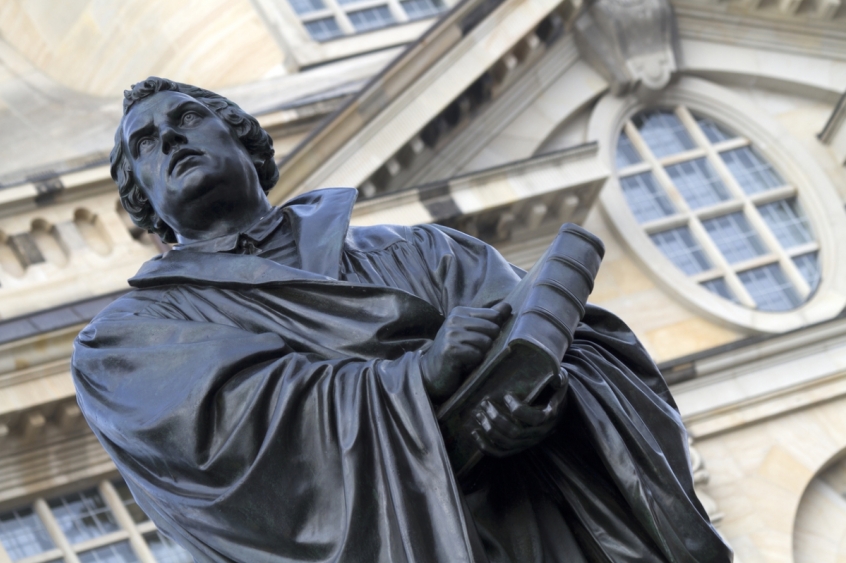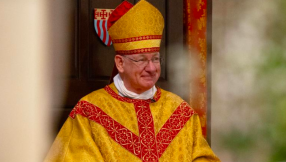
The writer of the Letter to the Hebrews reminds Christians that they are surrounded by a great "cloud of witnesses." (NRSV) That "cloud" has continued to grow in size since then. In this monthly column we will be thinking about some of the people and events, over the past 2000 years, that have helped make up this "cloud." People and events that have helped build the community of the Christian church as it exists today.
In 1521, Martin Luther (1483–1546) made his decisive break from the authority of the pope and the Holy Roman Emperor, following the Diet of Worms. Luther had been hoping to reform the Catholic Church. Growing resistance to his criticisms from within the hierarchy of the Church and its political allies meant this was not to be.
The emergence of Protestantism
From 1529 the term "Protestant" entered the vocabulary as some German princes backed Luther's calls for reform; they were also keen to restrict the power of the pope and the Holy Roman Emperor. By 1541 any hope of reconciliation between Catholics and Protestants broke down following the Diet of Regensburg. Years of indecisive warfare between the Catholic emperor and German Protestant princes led to the Treaty of Passau, in 1552, which recognised the continued existence of the Protestant German states; then the Peace of Augsburg (1555) ended this period of fighting.
For the rulers of these Protestant German states, the Reformation basically meant significant changes in the church but without this threatening the status quo in state and society. Something similar happened in Sweden and Denmark, where there was little violence or disruption to society.
The new German Lutheran church put great emphasis on the Bible and on preaching; rejection of Catholic devotion to the Virgin Mary and saints; the use of German (not Latin) in services; and the acceptance of married ministers in place of celibate priests. However, Lutheranism allowed ideas and practices associated with Catholicism, as long as they were not banned in the New Testament. This was in contrast to some other Protestants who only allowed things to continue if they were explicitly commanded in the Bible. As a result, Lutheranism, as it were, got off the "Reformation bus" several stops earlier than some other (so-called "Reformed") Protestants.
Elsewhere things were more complex. In France and the Netherlands, where rulers attempted to suppress the new ideas, there was violence and upheaval. Eventually the Catholic Counter-Reformation would roll back early Protestant advances in Bavaria, Poland, Austria, France, Belgium, and Bohemia.
In Switzerland a more austere Protestantism developed under Zwingli (1484–1531) in Zurich, and Calvin (1509–64) in Geneva. Zwingli and Calvin stayed on the "bus" much longer than Luther. In fact, Zwingli and Luther eventually irretrievably broke off relations. In the Swiss churches there was a much more intense form of Protestantism. War flared in Switzerland between Protestant and Catholic cantons, but Protestantism survived and Zwingli's Zurich and Calvin's Geneva became standard bearers of a more "Reformed" kind of Protestant church than was developing in the Lutheran areas. In Geneva, for example, anything not explicitly mentioned in the Bible was forbidden in church services; ornaments and statues were removed; preachers wore simple robes instead of ornate vestments; musical instruments were banned, and congregational hymn singing was unaccompanied.
The Swiss model was radical in its impact but did not fundamentally disturb the economic status quo. However, there were others who felt that the challenge to the Catholic Church was only the start of a much more radical reordering of society. Their version of the Reformation is often forgotten.
The 'other Reformation'
There were those who were committed to challenging the fabric of society, as well as the beliefs and practices of the church. Though they were not strictly part of the process of Reformation, huge numbers of peasants who rose in revolt across Germany in 1524 and 1525 took their cue from a sense of radical change being possible. They were the unintended results of the Reformation upheaval, and they suffered as its collateral damage.
This social revolt sparked wildly different reactions among early Protestant reformers. Luther condemned them. One can get a flavour of his attitude from the title of a pamphlet that he wrote - Against the Murdering Plundering Hordes of Peasants, in which he advised lords to crush the revolt. Huge numbers of peasants were killed.
On the other hand, some Christian leaders, of a more revolutionary disposition, applauded the revolt and later sought to emulate its attack on the wealth and power of the world. As a result, among many south German peasants there would be calls for a much more radical definition of "Reformation", in defiance of Luther and the established order. These were the "Anabaptists," whose exploits would later thrill or horrify different groups among "the godly," depending on their predilection. Clearly, the Reformation was to have both a socially conservative and a revolutionary track.
The fragmentation of papal power had allowed the appearance of groups well to the left of Luther and with more challenging ideas. Those termed "Anabaptists" believed that only adult believers should be baptized; church members should elect their leaders and be involved in church decision-making; and that all beliefs should come from the Bible only. The belief in adult believers' baptism was a revolutionary statement since, if a person could choose faith (rather than it be mediated through family and church hierarchy or state power), then it was not much further to claim political rights too. And many did.
Some were pacifists, such as the Mennonites in Germany and the Netherlands. On the other hand, a minority were prepared to use force to enact change. Some were communistic, such as the pacifist self-sufficient Hutterite communities in southern Germany and Bohemia. Most were lower class or of a middling sort. They were feared by those who had more of a stake in society and by those who feared the disintegration of a national church into fragmented individual congregations.
Anabaptists were executed by other Protestants in Zurich; by Catholics in Moravia; and in semi-reformed England, where they were opposed both by Catholics seeking to defend the old ways and by Protestants espousing the establishment of a state-led Protestant church.
With their challenges to church, state, society, and economy it is hardly surprising that they excited a great deal of opposition. Soon, the term "Anabaptist" became a loose form of abuse, like "Red" in the 1960s. As late as 1662, the English Book of Common Prayer found it necessary to state: "The Riches and Goods of Christians are not common, as touching the right, title, and possession of the same, as certain Anabaptists do falsely boast." They had clearly made an impact on the consciousness of those in power.
Many later Baptists were quick to deny any connection with the earlier "Anabaptists," despite the fact that – like these earlier radicals – they also rejected infant baptism. The "Anabaptist brand" had become seriously tainted with social extremism; at times with outright heresy.
In the year 1534, John Mathias or Matthys of Haarlem (in the Netherlands) and John Buckhold or Bockelson of Leiden (also in the Netherlands) led a group of extreme Anabaptists who seized control of the city of Münster in Westphalia, Germany. What followed went far beyond theological experiment and social change. Instead, the social order of the city was violently turned upside down. A reign of terror was soon in place and old patterns of behaviour abandoned. There were precedents for this in the so-called Bundschuh (peasants' clog) uprisings that had eventually escalated into the German Peasants' War. These lower-class uprisings declared nothing less than a God-sanctioned overturning of the social order. It was something like this that soon began to emerge at Münster.
Lutherans and Catholics were expelled from the city, the Anabaptists there being as antagonistic to one as the other. The city itself was soon besieged by the Bishop of Münster who found himself locked out of his own town. Claiming to be a prophet, Mathias and his supporters began a reign of terror against critics. They seized all gold and silver and held it communally. All books were destroyed since they offered alternative sources of knowledge. In March 1534, Mathias was convinced that he had been ordered by God to take a small force out of the city to break the siege. He did so and was killed. He was replaced by John Buckhold – sometimes remembered as "Jan of Leiden" – who took the title "King of Justice, King of the New Jerusalem".
Buckhold proclaimed a policy of polygamy and then took fifteen wives. Women who refused to be given in arranged marriages were executed on Buckhold's orders. All sexual norms had soon broken down in the city. But things soon escalated ever further. In August 1534, John declared that he, not Christ, was "Messiah of the Last Days", and would rule the world as a descendant of the Old Testament King David. Buckhold's coinage proclaimed, "The Word has become Flesh and dwells in us" and it was clear that this referred to him. While the city starved, he lived in luxury but proclaimed that, since he was dead to the world, there was no sin in this.
Finally, in 1535, the besiegers gained entry to the town. They slaughtered the Anabaptists and captured "King John." In 1536, he was tortured to death with red-hot irons. Despite the crushing of the revolt, others took inspiration from the example. In 1567, a cobbler who was named Jan Willemsen, set up yet another "New Jerusalem". This was also in Westphalia and, as with Buckhold, he declared he was the messiah. In time, he and his supporters were captured and executed; Willemsen himself was burnt at Cleves in 1580.
The impact of the 'other Reformation'
There was nothing about Anabaptist beliefs that made the horrors of Münster inevitable. The Mennonites and Hutterites are testimony to that; as were the moderate Baptist congregations which emerged in the seventeenth century. But Münster did offer a salutary lesson in what could happen if traditional social order broke down. Those who defended the social and religious order (or who wanted it to change without social and economic upheaval) explicitly kept referring to Münster as a warning.
However, among those who dreamed of more radical changes in society, it was claimed that its memory had been distorted by its detractors, to undermine Anabaptists. Theirs was a very different version of history and a very different kind of hero, compared with those who looked to Luther, Zurich, or Geneva as a model of change, but accompanied by social discipline.
As things unravelled during the British Civil Wars, in the 1640s and 1650s, the "godly" became polarized over whether the Kingdom of God they believed that they were constructing would be more like Geneva or Münster. The Reformation had more than one track.
Martyn Whittock is an evangelical historian and a Licensed Lay Minister in the Church of England. The author, or co-author, of fifty-six books, his work covers a wide range of historical and theological themes. In addition, as a commentator and columnist, he has written for several print and online news platforms and been interviewed on TV and radio news and discussion programmes exploring the interaction of faith and politics.
His most recent books include: Daughters of Eve (2021), Jesus the Unauthorized Biography (2021), The End Times, Again? (2021), The Story of the Cross (2021), and Apocalyptic Politics (2022). In his book When God was King: Rebels & Radicals of the Civil War & Mayflower Generation (2018) he explored the impact of the radicals of the Reformation, alongside their better known contemporaries.













